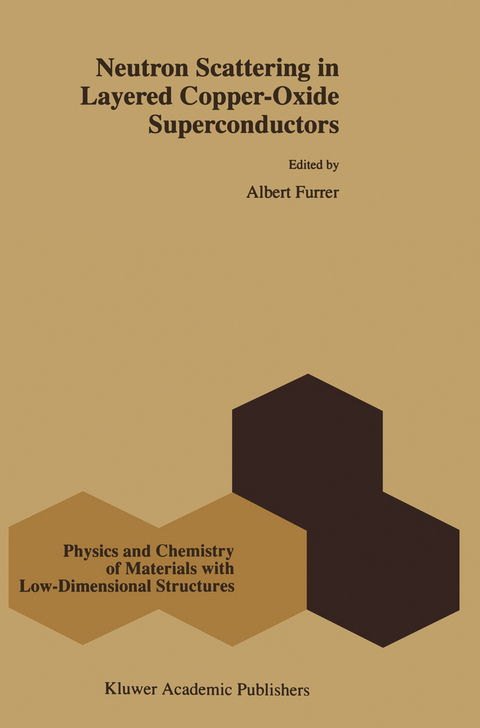
Neutron Scattering in Layered Copper-Oxide Superconductors
Springer (Verlag)
978-0-7923-5226-6 (ISBN)
to Neutron Scattering.- 1. Introduction.- 2. Properties of the neutron.- 3. Neutron scattering cross section.- 4. Coherent and incoherent scattering.- 5. Magnetic scattering.- 6. Polarization analysis.- 7. Instrumental aspects.- 8. Examples.- 9. Conclusions.- References.- Structural Anomalies, Oxygen Ordering and Superconductivity in YBa2Cu3O6+x.- 1. Introduction.- 2. Structure determination.- 3. Structural properties as a function of oxygen content.- 4. The x-T phase diagram.- 5. Quenching and “ageing” effects at room temperature.- 6. “Local” structural effects in oxygen-rich YBa2Cu3O6+x (x?1).- 7. Substituted compounds.- 8. Hole count, and phase separation: Overdoping and pressure effects.- Acknowledgements.- References.- Phase Diagrams and Spin Correlations in YBa2Cu3O6+x.- 1. The temperature-concentration phase diagram.- 2. The insulating phases.- 3. Magnetic fluctuations in the metallic state.- 4. Impurity effects: YBa2(Cu1-yZny)3O6+x.- 5. Discussion and conclusion.- Acknowledgments.- References.- Magnetic Excitations in La2-x(Ba,Sr)xCuO4.- 1. Introduction.- 2. The insulating antiferromagnet, La2CuO4.- 3. The normal metal.- 4. The superconducting metal.- Phonon Dispersions and Phonon Density-Of-States in Copper-Oxide Superconductors.- 1. Introduction.- 2. T-phase compounds.- 3. T’-phase compounds.- 4. 123-compounds.- 5. Bi-based compounds.- 6. Tl-based compounds.- 7. Hg-based compounds.- 8. Conclusive remarks.- References.- Phase Separation, Charge Segregation, and Superconductivity in Layered Cuprates.- 1. Introduction.- 2. Phase separation in La2CuO4+?.- 3. Charge segragation within the CuO2 planes.- 4. Concluding remarks.- Acknowledgments.- References.- Magnetic 2-D and 3-D Ordering Phenomena in Rare-Earth Based Copper-Oxide Superconductors andRelated Systems.- 1. Introduction.- 2. Crystal structure aspects.- 3. Magnetic neutron diffraction.- 4. Magnetic copper ordering.- 5. Magnetic rare-earth (R) ordering.- 6. Dipolar interactions and crystal-field effects.- 7. Discussion and conclusions.- Acknowledgements.- References.- Collective Magnetic Excitations of 4f Ions in R2-xCexCuO4 (R=Nd, Pr).- 1. Introduction.- 2. Theory of 4f magnetic excitations.- 3. Rare-earth magnetic properties in R2-xCexCuO4 (R=Nd,Pr).- 4. Dispersion of CEF excitations.- 5. Spin waves in Nd2-xCexCuO4.- 6. Conclusions.- Acknowledgements.- References.- The Crystal Field as a Local Probe in Rare-Earth Based Copper-Oxide Superconductors.- 1. Introduction.- 2. The crystal-field (CF) interaction.- 3. Examples.- 4. Doping effects.- 5. Linewidth of CF excitations.- 6. Conclusions.- Acknowledgements.- References.- Small-Angle Neutron Scattering Experiments on Vortices in Copper-Oxide Superconductors.- 1. History and introduction.- 2. The interaction between flux lines and neutrons.- 3. Experimental geometry for SANS.- 4. Flux lattice structure, orientation, pinning and melting.- 5. Experimental results on flux lattice structures in YBCO.- 6. Experimental results on flux lattice structures in BSCCO-2212.- 7. Flux lattice melting.- 8. Other information from diffraction.- 9. Neutron depolarisation.- 10. Comparison with other superconductors.- 11. Summary and outlook.- Acknowledgements.- References.
| Erscheint lt. Verlag | 30.9.1998 |
|---|---|
| Reihe/Serie | Physics and Chemistry of Materials with Low-Dimensional Structures ; 20 |
| Zusatzinfo | XIV, 406 p. |
| Verlagsort | Dordrecht |
| Sprache | englisch |
| Maße | 155 x 235 mm |
| Themenwelt | Naturwissenschaften ► Physik / Astronomie ► Atom- / Kern- / Molekularphysik |
| Naturwissenschaften ► Physik / Astronomie ► Festkörperphysik | |
| Naturwissenschaften ► Physik / Astronomie ► Thermodynamik | |
| Technik ► Maschinenbau | |
| ISBN-10 | 0-7923-5226-2 / 0792352262 |
| ISBN-13 | 978-0-7923-5226-6 / 9780792352266 |
| Zustand | Neuware |
| Haben Sie eine Frage zum Produkt? |
aus dem Bereich


